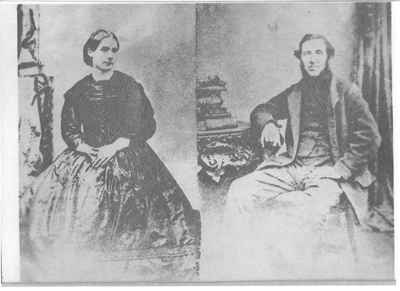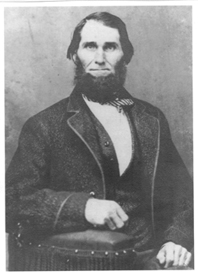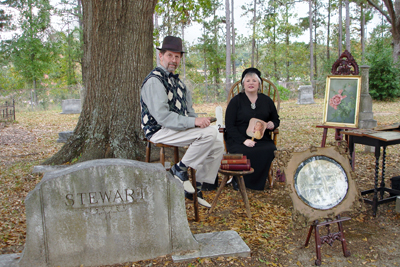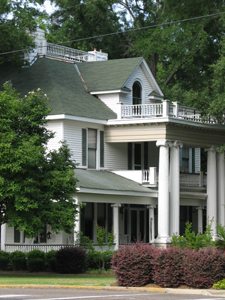A property with historical significance
One of the most
talked about issues currently in Minden is the status of
the property located at 110 Homer Road, owned by Craig
and Mona Farley. I would be less than candid if I didn’t
admit that the writing of this column today was not
caused by the present controversy. The genesis of this
article began in the Spring after the first public
discussion and I am writing it at this point because of
things I have been told by both sides of the arguments.
I really hate to use the word sides; in this matter. I
wish we were all on the same side; what is best for
Minden. I have good friends on both sides; that I have
worked with on many projects over the years. This is not
an advocacy piece for either side; the eventual use of
that property will be worked out by the owners and our
city government.
The Berry Plantation
 The purpose of
this column today is to discus the historical
significance of the property; or rather what is probably
the greatest historical significance of the property. It
is one that has somewhat escaped attention in this
matter as the focus has been on the historic Stewart
Home and on the contributions of the Stewart family to
Minden. Those are both very important elements of our
history. But the event that had the deepest and the
longest lasting impact related to that property took
place nearly half a century before the Stewart Home was
built in the waning days of the Civil War, when,
according to local tradition and some written sources
the land in question was part of the Berry Plantation;
home of pioneer settler J. W. Berry.
The purpose of
this column today is to discus the historical
significance of the property; or rather what is probably
the greatest historical significance of the property. It
is one that has somewhat escaped attention in this
matter as the focus has been on the historic Stewart
Home and on the contributions of the Stewart family to
Minden. Those are both very important elements of our
history. But the event that had the deepest and the
longest lasting impact related to that property took
place nearly half a century before the Stewart Home was
built in the waning days of the Civil War, when,
according to local tradition and some written sources
the land in question was part of the Berry Plantation;
home of pioneer settler J. W. Berry.
*Photo Above: Col
Berry and Camilia Hadley Berry
Black Soldiers
As I
write this article I must confess I do not know the
exact boundaries of the land owned by J. W. Berry in
Minden in 1865. That is perhaps the weakest part of my
research skills; I am not very well schooled in
researching land ownership. However, this will be an
ongoing project and one of my next endeavors will be to
establish the precise territory covered by the Berry
estate. What is an established historical fact is that
from May until December 1865 forces of the 61st United
States Colored Troops lived on the Berry Plantation in
24 cabins built by the soldiers after they arrived in
Minden. These African- American troops, most of whom
were freed slaves from Tennessee, Northern Mississippi
and Northern Alabama, were the occupation army charged
with reestablishing the control of the United States
government over Minden and protecting the rights of the
newly freed slaves. The interaction between those forces
and the residents of Minden marks the beginning of what
would be a century long process that eventually allowed
African Americans to become full partners in
citizenship. In 1840, the first Federal Census taken
after the founding of Minden, Claiborne Parish (of which
Minden was a part until 1871) had a population of 3,846
white residents and 2,339 residents classed as persons
of color; all but 44 of those persons of color were
slaves. By 1860, on the eve of the Civil War, the total
white population was at 8,996, while the slave
population had grown even more rapidly to a total of
7,848 (by 1860 there were only 4; free persons of color
in all of Claiborne Parish). Thus, interaction between
the races increased strictly because of a nearly split
population. The 1870 Census would find Minden and
Webster Parish in a new world in terms of the social
order. In that year, the African- American population in
Claiborne Parish had climbed to 10,608, exceeding the
white population of 9,630. In addition, the social
structure of the South had been recreated, with the
freed slaves as full members of society. It would take
many, many years for a balance to be achieved in our
society. (Some might argue it has not yet been
achieved.) In many ways those six months between May and
December 1865 when the African-American soldiers
occupied Minden became a microcosm of the century to
follow with all the challenges and triumphs, tragedies
and progress the following decades would entail. In this
article I will briefly give you some of the facts we do
know about that period.
Union Forces
 With the evacuation
of Shreveport and North Louisiana by the Confederate
Army of the Trans-Mississippi in May 1865, Union forces
gradually moved into our area. As part of the;
punishment; phase intended by the United States Congress
in the aftermath of the assassination of Abraham
Lincoln, almost all the South was to be occupied by
units of the United States Colored Troops. These units
were composed of African-American soldiers from both the
North and the South serving under white officers that
had been formed following the issuance of the
Emancipation Proclamation in 1863. The story of perhaps
the most famous of these units, the 54th Massachusetts
Infantry, is told in the movie Glory. The troops that
eventually came to Minden had originally been known as
the 2nd Tennessee Infantry of African Descent or the 2nd
West Tennessee Infantry Regiment, formed at La Grange,
Tennessee in the summer of 1863. In March 1864, they
were given the USCT nomenclature by which they are
officially known as; the 61st United States Colored
Troops.
With the evacuation
of Shreveport and North Louisiana by the Confederate
Army of the Trans-Mississippi in May 1865, Union forces
gradually moved into our area. As part of the;
punishment; phase intended by the United States Congress
in the aftermath of the assassination of Abraham
Lincoln, almost all the South was to be occupied by
units of the United States Colored Troops. These units
were composed of African-American soldiers from both the
North and the South serving under white officers that
had been formed following the issuance of the
Emancipation Proclamation in 1863. The story of perhaps
the most famous of these units, the 54th Massachusetts
Infantry, is told in the movie Glory. The troops that
eventually came to Minden had originally been known as
the 2nd Tennessee Infantry of African Descent or the 2nd
West Tennessee Infantry Regiment, formed at La Grange,
Tennessee in the summer of 1863. In March 1864, they
were given the USCT nomenclature by which they are
officially known as; the 61st United States Colored
Troops.
*Photo Above: J.W.
Berry John Agan
Col. John Foley
The commander of the 61st USCT
who was headquartered part of the time in Shreveport and
part of the time here in Minden was Lt. Colonel John
Foley. What follows is his biography from the history of
Greenwood County Kansas, written in honor the Centennial
of Independence in 1876.
COL. JOHN FOLEY, farmer,
Section 33, Township 25, Range 13, P. O. Quincy, was
born in 1830, in Clark County, Ohio, and until fourteen
years of age alternated between school and his father's
farm. When fourteen he became apprenticed to the trade
of harness-making, at which he worked until eighteen
years of age, when he engaged in the cattle and stock
business until December, 1861, when he enlisted in
Company H, Sixty-second Illinois Volunteer Infantry, and
upon the organization of the regiment, in February,
1862, was commissioned First Lieutenant. He remained
with his regiment until May, 1863, when he was
authorized to raise a colored regiment, which he did in
Jackson and La Grange, Tenn., being subsequently
commissioned Colonel of the same, known as the
Sixty-first Regiment United States Colored Infantry. He
continued in command until the regiment was mustered out
at Baton Rouge, February, 1866. At the close of the war
Col. Foley returned to Illinois and engaged in farming
until his removal to Kansas in October, 1870. His farm
of 160 acres upon the Verdigris River is nearly all
under cultivation, his average yield of corn being
thirty-eight bushels to the acre, and millet two and a
half tons per acre. At present he has only sixty head of
cattle, and six or seven horses. In 1855, he married
Miss Elizabeth Kendall, of Bloomington, Ill., by whom he
has four children-Jacquetta, born June 17, 1862; Eugene,
born March 5, 1868; Lena, born October 21, 1871, and
Lulu, born December 22, 1876; Col. Foley has been two
years County Commissioner, and for the past three years
has been one of the trustees of Quincy Township.
Captain
Graff
When Foley took over command of
the 61st, he brought with him Charles Graff, a Sergeant
in his old Illinois unit. Graff would receive a
promotion to Captain in the new unit and based on the
account of Marshall Harvey Twitchell, the famed
carpetbagger whose control of Red River Parish led to
the Coushatta Massacre during Reconstruction; it was
Graff who actually commanded the forces at Minden,
Company I of the 61st. Twitchell came to Louisiana
during the summer of 1865 to become the Freedman’s
Bureau Agent at Sparta, then the seat of Bienville
Parish. In that role he had to call on the military
forces at Minden and Captain Graff for help on at least
two occasions. The 61st was at first used to occupy the
City of Memphis from March to July 1864. During that
time Col. Foley was for a time the military officer in
charge of the city. Gradually the Union Army began to
use the Colored Troops for more than just garrison duty
beginning with the famous efforts of the 54th
Massachusetts at Fort Wagner, South Carolina and the
Louisiana Native Guards at Port Hudson. The 61st first
saw combat in an expedition to capture Tupelo,
Mississippi in July 1864. They went on to fight in
several battles in Mississippi and defend the city of
Memphis from an attack by Gen. Nathan Bedford Forests
Confederate Calvary.
Chaotic Times
Early in 1865 they were sent to
New Orleans and spent the waning days of the war as
occupation forces in South Louisiana and in Mississippi.
It is at this point that tracing the actions of the unit
becomes more difficult. The ending days of the Civil War proved to be
very chaotic times for the United States Government.
Many people do not realize how close this nation came to
military rule (the entire country, not just the former
Confederacy which would eventually endure military rule
during Reconstruction.) The assassination of Abraham
Lincoln in the failed coup attempt of John Wilkes Booth,
followed by the ascension to the Presidency of Andrew
Johnson, a Southerner, caused many of the Radical
Republicans in Congress to contemplate turning control
of the government over to the United States Army. That
uncertainty is reflected in the official records of the
day. The collected military orders of the war time
period are assembled in what has come to be called the;
War of the Rebellion; by students of the Civil War. The
references to the 61st in those 70 volumes tell us that
the unit was sent to Alabama in May 1865 where it stayed
until being mustered out on December 30, 1865.
difficult. The ending days of the Civil War proved to be
very chaotic times for the United States Government.
Many people do not realize how close this nation came to
military rule (the entire country, not just the former
Confederacy which would eventually endure military rule
during Reconstruction.) The assassination of Abraham
Lincoln in the failed coup attempt of John Wilkes Booth,
followed by the ascension to the Presidency of Andrew
Johnson, a Southerner, caused many of the Radical
Republicans in Congress to contemplate turning control
of the government over to the United States Army. That
uncertainty is reflected in the official records of the
day. The collected military orders of the war time
period are assembled in what has come to be called the;
War of the Rebellion; by students of the Civil War. The
references to the 61st in those 70 volumes tell us that
the unit was sent to Alabama in May 1865 where it stayed
until being mustered out on December 30, 1865.
Records
However, local tradition, but
more importantly contemporary newspaper accounts tell us
a different story. It is clear that elements of the 61st
were sent to Northwest Louisiana where they occupied
Shreveport and the surrounding communities, including
Minden. Why those orders do not appear in the official
records can partially be explained by the ongoing battle
between Congress and the President over who would
administer the Reconstruction of the South. Records of
the individual men who served in the 61st indicate that
the unit actually disbanded, at least the units that
were here, in February 1866 in Louisiana. Minden had
been home to a rather large Quartermaster’s Depot
located in the vicinity of the present intersection of
East Union and Talton Streets in the Warsaw Community.
The Depot was turned over to Union forces on about May
15, 1865 by Colonel Nicholas Floyd of Virginia. (Floyd
had married a young lady from a prominent Minden family
during his stay and took his bride back to Virginia with
him.) But those forces were not from the 61st. The first
concrete reference to the presence of the occupation
troops comes in June 1861.
Latter 1865

In next Week’s Echo, we will
look at the few facts we do know of what took place here
in Minden in that last half of 1865 as the residents of
Minden dealt with a social structure that had been
turned upside down along with the rigors of martial law.
There are some embarrassing moments but some rays of
hope that shine through the story. We will also look at
the difficulties faced in trying to recreate what
happened here because of the relatively short lives of
the Union officers who led the occupation. Most
intriguing is the mysterious story surrounding one
particular soldier from the 61st; the role he would play
in Minden’s history and the puzzle he has left for
researchers to sort out in trying to understand those
turbulent days. All of these questions and these stories
centered around that property at 110 Homer Road then on
the northern fringe of Minden, but today at the heart of
the city and the heart of controversy.
John Agan is a local historian,
an Instructor at Bossier Parish Community College, and a
published author. His column appears Fridays in the
Minden Press-Herald.